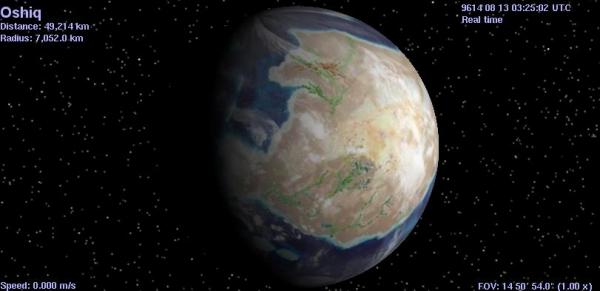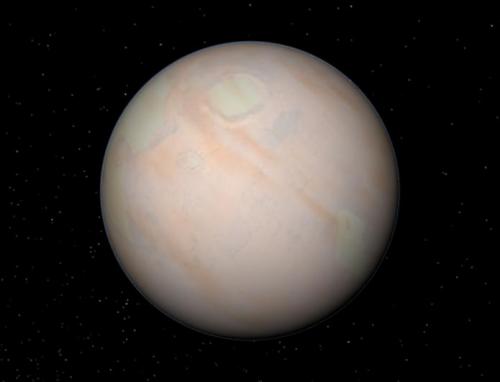BY LETTER
Oshiq
Galactography > Regions of Space > Outer Volumes
Galactography > Sephirotic Empires > Solar Dominion
Galactography > Systems and Worlds > Systems & Worlds O - P
Galactography > Sephirotic Empires > Solar Dominion
Galactography > Systems and Worlds > Systems & Worlds O - P
 Image from Steve Bowers | |
| The planet Oshiq is slowly drying out as the local star gets warmer | |
Oshiq - Data Panel | |
| System: | Oshiq |
|---|---|
| Primary: | JD 9802-8 |
| Stellar Type: | G2V |
| Companion: | nil |
| Region: | Distance 3210 ly from Sol; Constellation Perseus |
| Allegiance | Solar Dominion Outer Sectors |
| Planets: | Planet: c 'Oshiq' Diameter 14103 km Class Postgaian |
In some ways humanity discovered the world of Oshiq ten million years too late; until that date the climate of this world was comfortable, and Oshiq would have been counted among the rare class of garden worlds which need no alteration whatever before colonisation.
Complex lifeforms evolved on Oshiq two billion years ago, and for a billion years a system of biofeedback regulation maintained the climate within a range of temperatures suitable for a complex ecosystem. However the local star, JD 9802-8, has followed the normal evolution of a main sequence star and continues to gradually increase in brightness. When life evolved the star was 15% cooler, and a global greenhouse effect warmed the world so that ice ages were rare and short-lived; the star was warmer when the carbon dioxide levels in the atmosphere dropped at one hundred million years b.p.e..
This was the time of the great forests and ocean weedmats; by 10 million years b.p.e the sun was getting too warm for biofeedback to ameliorate, so the deserts were beginning their final encroachment.
At this time the mysterious alien species known only as the Labyrinth Builders established a small colony here; little remains of their artefacts, apart from a few short tunnels filled with rubble which once was high tech equipment. No readable data can be retrieved from the Builder remains; they disappeared from this world (and the few others they colonised) for an unknown reason within less than a thousand years.
As the abandoned world increased in temperature the water vapour in the atmosphere increased; apart from high thin cloud the cloud cover gradually disappeared and rain became infrequent. As water vapour is a good greenhouse gas the temperatures began to rise steadily, and the ocean level fell by more than a hundred meters. The world of Oshiq will soon develop into a moist greenhouse world, with boiling seas, doomed without technological intervention.
At the top of the atmosphere the increased water vapour component gradually being destroyed by the brighter sunlight; hydrogen boils off, while the oxygen combines with the rocks of the heated world. By the time the Solar Dominion arrived in 8744 the temperature of the oceans averaged 47 Celsius, while the interior of the largest continent frequently exceeded the boiling point of water. Despite this life has continued to exist in certain ecological refuges, and displays many unusual adaptations.
As the atmosphere of Oshiq contains a respectable amount of water vapour it is possible for precipitation to occur, which may be heavy at times; this mostly occurs in mountainous regions (orogenic rainfall). A monsoon-like seasonal rainfall occurs in the Senilia mountains, bringing life to the dry valleys. Where rainfall occurs it rapidly evaporates again, so the photosynthetic plant-like organisms all maintain a large reservoir of water within their structure. Funnel-leafed plant-likes can reach ten metres across, collecting water in their bloated underground caudex/stem; some species maintain a symbiotic biota within this reservoir and also upon the outer waxy leaf surfaces. One particularly useful partner is the dust-bug, a five-legged motile organism which tirelessly removes wind-blown loess from the upper surfaces of the funnel-leaf.
Most of the continental surface of this hot planet has been reduced to searing hot desert, and the soil has lost its living component, so that it is constantly redistributed by the hot winds. All Oshiq plant-likes are hermetically sealed during the daytime, to avoid damage from the hot daytime air; at night splits and slits open to allow carbon dioxide in which is stored for photosynthesis during the day (mostly involving chlorophylls A and B, rarely xanthophylls).
CO2 is increasing in abundance in the atmosphere, as most of the old biosphere is now completely oxidised, and volcanic sources outgas at a steady rate but little can be dissolved in the hot oceans to enter the crust via the subduction process and so the carbon cycle is broken. Despite this the oxygen levels are also still high in the increasingly dense atmosphere.
During the night heavy dews are absorbed by the gaping plant-likes, and the captured water reservoirs are maintained; hermetically sealed pebbleplants extend a high surface area frond at night to harvest the dew when the temperature drops, but seal themselves again during the day against the heat, using the collected water as a heat sink.
The bottoms of the river valleys and the gently sloping exposed continental shelf areas contain many oases, most of them actively preserved by the actions of various life forms. A layer of water, or more often a thick bed of mud is sealed off from the midday heat by several layers of waxy plantlike organisms, ranging in size from microscopic to several metres across. These grey-green plant-likes effectively seal the water in the moist layers of mud below and allow an ecosystem to develop; as the mudpools are often isolated from each other, evolution has been occurring rapidly. In many cases the top layer of plantlikes rotate gently to avoid encrustation by gypsum and halite deposits, which build up around the edges of the oases in concreted mounds.
A rich animal-like fauna can be found in the waters and muds; worms and piscine forms abound. Much of the life in these stagnant ponds relies on anaerobic respiration, but not all. Fish-like and segmented forms swim or burrow through the mud, depending on how thick it is. The largest herbivore is the Undercow, a large blue creature with a wide mouth for skimming the surface plants from underneath. Almost totally submerged, the Undercow can be spotted by the long china-like breathing tubes or horns near the mouth, and the short trail of open water left behind after it has eaten its way through the photic layer. The plantlikes respond to this disturbance by quickly closing ranks to prevent water loss.
The ancient anaerobic ecology dependent on the thermal energy of the mid-ocean ridges on Oshiq has changed little since the onset of the moist greenhouse climate regime but the former chemotrophic ecology based on methyl hydrates has been lost, together with most oxygen breathing sea-life; the water is now too warm to retain much oxygen, or to allow methyl hydrates to remain on the ocean floors. When the land finally becomes too warm for life to continue there, the bottom of the sea, and perhaps the upper atmosphere, may still support a few hardy extremophiles into the far future.
The local demiurge of the Dominion has decided to leave Oshiq untouched, although representative biospheres have been established in 2000km ring habitats in the outer system; this planet and its unusual biota will be allowed to develop without interference, while the biospheres on the artificial rings are available for modification (if that is considered desirable).
 Image from Steve Bowers | |
| Noachos - a wet Mars-like world in this system | |
Related Articles
Appears in Topics
Development Notes
Text by Steve Bowers
Rachel Denley Bowers for the 'Undercow' concept, and Mary Denley for the name of this world
Initially published on 14 May 2004.
Rachel Denley Bowers for the 'Undercow' concept, and Mary Denley for the name of this world
Initially published on 14 May 2004.






